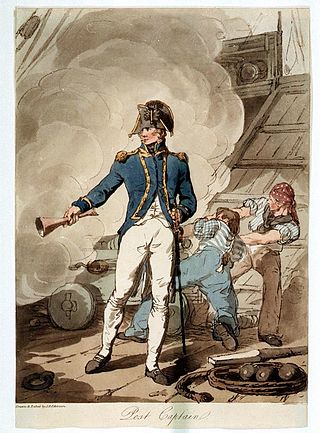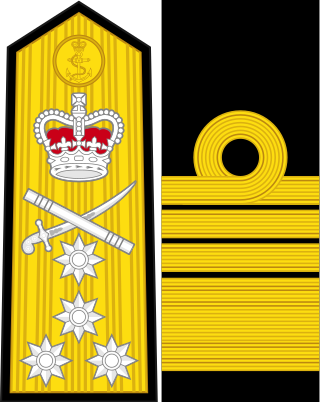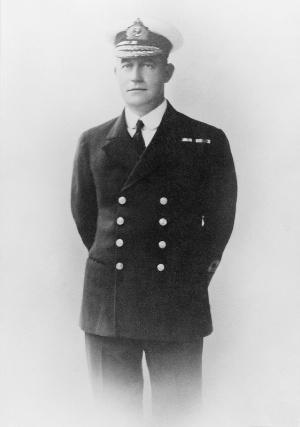
Post-captain is an obsolete alternative form of the rank of captain in the Royal Navy.

Admiral Sir Graham Moore was a Royal Navy officer. As a junior officer he took part in the Great Siege of Gibraltar during the American Revolutionary War. As captain of the frigate Melampus, he took part in the Battle of Tory Island in October 1798, capturing the French frigate Résolue two days later, during the French Revolutionary Wars. He went on to be First Naval Lord, then Commander-in-Chief, Mediterranean Fleet, and finally, Commander-in-Chief, Plymouth. He was the younger brother of General Sir John Moore.

The Home Fleet was a fleet of the Royal Navy that operated from the United Kingdom's territorial waters from 1902 with intervals until 1967. In 1967, it was merged with the Mediterranean Fleet creating the new Western Fleet.

Admiral of the Fleet Sir George Astley Callaghan was an officer in the Royal Navy. During the Boxer Rebellion he served as commander of a naval brigade sent ashore to form an element of a larger expedition under Lieutenant-General Sir Alfred Gaselee: the expedition entered Peking and rescued the legations which had been held hostage there. He came to prominence again when, as Second-in-Command of the Mediterranean Fleet, he assisted with the provision of aid to survivors of the Messina earthquake, which had caused the loss of circa 123,000 lives.

Admiral Sir John Thomas Duckworth, 1st Baronet, GCB was an English officer of the Royal Navy, serving during the Seven Years' War, the American War of Independence, the French Revolutionary and Napoleonic wars, as the Governor of Newfoundland during the War of 1812, and a member of the British House of Commons during his semi-retirement. Duckworth, a vicar's son, achieved much in a naval career that began at the age of 11.

Admiral is a senior rank of the Royal Navy, which equates to the NATO rank code OF-9, outranked only by the rank of admiral of the fleet. Royal Navy officers holding the ranks of rear admiral, vice admiral and admiral of the fleet are sometimes considered generically to be admirals. The rank of admiral is currently the highest rank to which a serving officer in the Royal Navy can be promoted, admiral of the fleet being in abeyance except for honorary promotions of retired officers and members of the Royal Family.

The Commander-in-Chief, The Nore, was an operational commander of the Royal Navy. His subordinate units, establishments, and staff were sometimes informally known as the Nore Station or Nore Command. The Nore is a sandbank at the mouth of the Thames Estuary and River Medway. In due course the Commander-in-Chief became responsible for sub-commands at Chatham, London, Sheerness, Harwich and the Humber.

Admiral Sir George Francis Hyde, was an English-born Australian admiral, known as a former head and the first officer to achieve the rank of full admiral in the Royal Australian Navy.

Vice-Admiral Kenneth Gilbert Balmain Dewar, CBE was an officer of the Royal Navy. After specialising as a gunnery officer, Dewar became a staff officer and a controversial student of naval tactics before seeing extensive service during the First World War. He served in the Dardanelles Campaign and commanded a monitor in home waters before serving at the Admiralty for more than four years of staff duty. After the war ended he became embroiled in the controversy surrounding the consequences of the Battle of Jutland. Despite this, he held a variety of commands during the 1920s.

Sir Richard Dacres was an officer of the British Royal Navy who saw service during the American War of Independence, and the French Revolutionary and Napoleonic Wars. A member of a substantial naval dynasty, he eventually rose to the rank of vice admiral.
Vice Admiral Sir Michael Culme-Seymour, 4th Baronet was an officer of the Royal Navy. A member of a substantial naval dynasty, he served during the First World War, commanding a ship at the Battle of Jutland in 1916. He received a number of awards and decorations, and served as commander-in-chief of the Mediterranean Fleet during the interwar period, and as Second Sea Lord. He inherited a baronetcy on the death of his father, but died shortly afterwards with the rank of vice-admiral.
Admiral Sir Sydney Robert Fremantle, was an officer of the Royal Navy, who served during the Victorian era and had risen to the rank of rear-admiral by the outbreak of the First World War. He played a role in developing fleet communications and signalling methods prior to the war, but was hampered in effectively implementing them due to the disruption caused by the conflict. He had an active seagoing career during the war, commanding several of the cruiser squadrons, and later taking command of the British fleet in the Aegean. Promoted to vice-admiral after the end of the war and given command of the First Battle Squadron, Fremantle oversaw the interned German High Seas Fleet at Scapa Flow, and was away on exercises when the sailors began to scuttle their ships in June 1919. He attempted to salvage what he could, later accusing the German commander, Vice-Admiral Ludwig von Reuter, of a shameful breach of honour. Fremantle rose to full admiral and commanded the naval base at Portsmouth, retiring in 1928. He wrote his memoirs, publishing them after the Second World War, and donated many of his papers to institutions before his death in 1958.

Admiral Sir Ernest Charles Thomas Troubridge, was an officer of the Royal Navy who served during the First World War.
Admiral Sir Geoffrey John Audley Miles, KCB, KCSI was a senior Royal Navy admiral who served as Deputy Naval Commander, South East Asia Command under Lord Mountbatten during the Second World War, as the Senior British Representative on the Tripartite Naval Commission and as the last Commander-in-Chief, Indian Navy of the unified Royal Indian Navy.

Commodore Submarine Service is a post in the Royal Navy which involves command of the Royal Navy Submarine Service. It evolved from the post of Inspecting Captain of Submarines in 1901 and would later evolve to become the post of Flag Officer Submarines in 1944.

The Commander-in-Chief, North Sea, was senior appointment and an operational command of the British Royal Navy originally based at Great Yarmouth from 1745 to 1802 then at Ramsgate from 1803 until 1815.

The Admiral Commanding, Reserves, was a senior Royal Navy post that existed from 1875 to 1976.
Admiral Crawford Maclachlan, CB was a Royal Navy officer.











